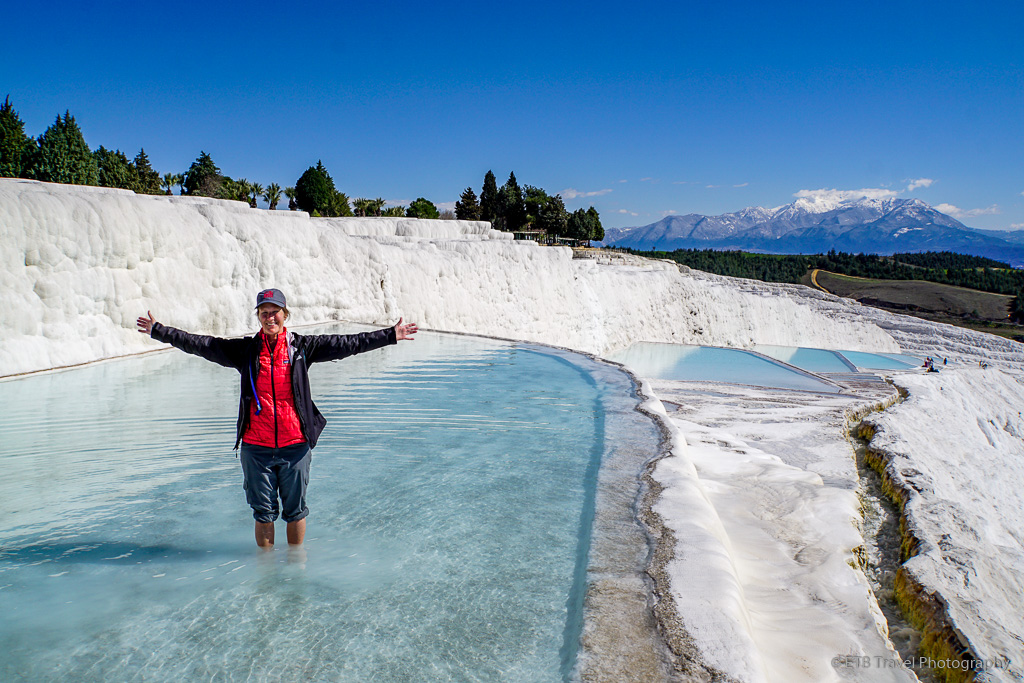I actually signed up for this G-Adventures tour, a budget National Geographic company, specifically because the itinerary included Pamukkale. Pamukkale is a UNESCO World Heritage Site which features natural travertine terraces of thermal pools. I saw a picture of the famous site in a National Geographic magazine at least 10 years ago and have wanted to visit ever since.
Heiropolis
I was surprised to find the Pamukkale very different from the photo. First and foremost, the natural wonder is next to ruins of a 2,000 year old city, Heiropolis. Heiropolis was founded by Eumenus II in 190 BC. Originally part of Pergamum, the city later became part of the Roman empire. Considered sacred due to the thermal waters, Heiropolis thrived and grew to a population of more than 100,000 citizens.
We started our tour of the area in Heiropolis after paying the 50 TYL ($9) entrance fee. While much of Heiropolis has been destroyed from previously constructed hotels that have since been removed, the theatre was very well maintained. It provided wonderful views of the vast grounds where doctors used the waters for cures. I couldn’t believe I didn’t know anything about the ancient thermal city which has attracted visitors for thousands of years.

Pamukkale Thermal
After exploring some ruins, we visited Pamukkale. Pamukkale has two areas. The first area features the sacred pool which is the source that feeds the natural pools. The pool used to be part of one of the aforementioned decommissioned hotels, but was saved and is considered a swim club.
The commercialized pool area includes a garden, restaurant, gift shop and changing room. Visitors may soak in the warm waters which are peppered with old Roman ruins. While enjoying the 95⁰ water, don’t forget emperors and kings used to weekend here.

Pamukkal Limestone Pools
Down the hill are a collection the limestone pools, white with calcium deposits. Many of the terraces were dry as the water had been diverted to man-made pools. The government does this to protect the area from tourist damage. While disappointing that the accessible terraces were dry, there were some below that were full.

Regardless, the man-made pools were quite picturesque. The white pools with aqua water descend the mountainside with views of snow capped mountains in the distance. Visitors may wade or soak in the pools, though in March the only water that is warm is a narrow canal used to fill them.
Some of the natural formations aside the pools are sharp while other surfaces with a light stream of water running over them are slick. As a result of both the air and water temperature, we only waded very carefully!

Necropolis
Mesmerized by the beauty and hopeful we could snap a photo without tourists in it, we lingered longer than planned. Despite a limited number of visitors due to COVID, the folks pictured above decided to relax in the narrow canal.
We gave up on the tourist free photo, especially when two Japanese girls stood in the pools taking every possible selfie imaginable. Moving on, we visited additional ruins, much of which was a necropolis. The necropolis includes the Tomb of Philip the apostle and hundreds of sarcophagi.

With a guide who studied archaeology and specialized in sarcophagi, we spent a long time admiring the ancient city. The ruins included the aforementioned necropolis, gates, Roman baths, and more.

Pamukkale was truly fascinating, not for what I expected…but for the unexpected. We really enjoyed our time visiting both the terraces known as the cotton castle from the white calcium deposits and Heiropolis, the holy city. Pamukkale is definitely worth a visit while in Turkey. Go on your own or find a tour on Viator. ETB
Want to Take This Article With You?
Click HERE for my offline, GPS guided travel article about Pamukkale and Heiropolis on GPSMyCity.
Other Articles About Turkey You May Like
- Istanbul: Sultanahmet District
- Istanbul: Beyoglu Region
- Istanbul: The Asian Side
- From Ankara to Konya
- Cappadocia: Three Day Itinerary
- All About Antalya
- The Sunken City of Kekova
- Selcuk: The Site of Ephesus
- From Selcuk to Ayvalik
- Canakkale, Turkey
Shop
Check out the photographic note cards and key chains at my shop. Each card has a travel story associated with it. 20% of proceeds are donated to charity.




I had to look up Sarcophagus!